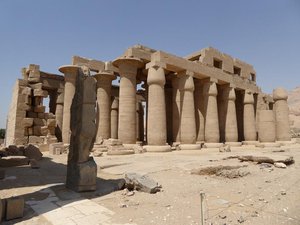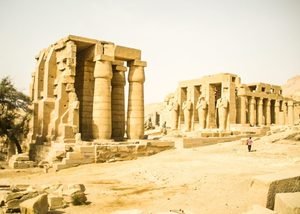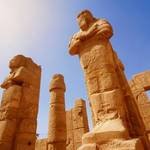Temple of Ramesseum
Today relatively little remains of what is thought to have once been the most
impressive temple complex on the West Bank of the Nile. Several clusters
of pillars and a few damaged statues stand among a large field of ridges, holes,
broken foundations, and pieces of statuary that mark out where the rest of the
the complex once stood. The reputation of this site now tied more to the reputation
Temple of Ramesseum
of the man, that commissioned it, rather than the appearance of its ruins.
Ramesses II the name most often heard in association with many of the monuments
around Luxor and further south. He a prolific builder and also had a habit
of repurposing existing monuments to add to his reputation.
He the greatest conqueror in the history of Ancient Egypt, ruling for 67 years
during the New Kingdom (1279—1213 BC) and extending the range of his kingdom
Temple of Ramesseum
into new frontiers in the south, west, and north in Syria.
This temple dedicated to him and a testament to his power and influence and
it meant to be the greatest of all monuments.
Plundering by subsequent pharaohs, who could no afford to quarry their own stones,
natural disasters, and finally these sites use as a church by early
Egyptian Christians have all taken a toll on this once great structure, but even
among the scattered ruins evidence of its greatness still persists.
Temple of Ramesseum
There the remains of a toppled colossus of Ramesses II that estimated to
have stood over six stories tall, the largest freestanding sculpture ever in Egypt
and one of the largest ever attempted anywhere in the world. The decoration of the
remaining columns in the hypostyle hall are also impressive, showing the fine craftsmanship
Temple of Ramesseum
with defined the Ramesseum’s construction.
Though relatively little remains, the Ramesseum is still an exciting visit, especially
for those with a particular interest in the life of Ramesses II,
the greatest of the pharaohs. Its layout was the inspiration for the much better-preserved
the temple complex at Medinat Habu, constructed by Ramesses III.
